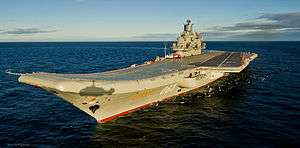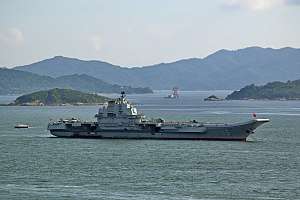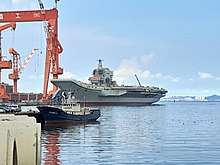Kuznetsov-class aircraft carrier
The Kuznetsov-class aircraft carrier (Russian: Авиано́сцы ти́па «Кузнецо́в»), Soviet designation Project 11435, is a class of fixed-wing aircraft carriers operated by the Russian and Chinese navies. Originally designed for the Soviet Navy, the Kuznetsov-class ships use a ski-jump to launch high-performance conventional aircraft in a STOBAR configuration. The design represented a major advance in Soviet fleet aviation over the Kiev-class carriers, which could only launch VSTOL aircraft. The Soviet Union's classification for the class was as a heavy aircraft-carrying cruiser, which permits the ships to transit the Turkish Straits without violating the Montreux Convention,[5] however the Chinese variants are classified as aircraft carriers.
 Admiral Kuznetsov in January 1996 | |
| Class overview | |
|---|---|
| Name: | Kuznetsov class |
| Builders: | |
| Operators: | |
| Preceded by: | Kiev class |
| Succeeded by: |
|
| Subclasses: | |
| Built: | 1 April 1982–present |
| In commission: | 25 December 1990–present |
| Completed: | 3 |
| Active: | 2 (+1 undergoing refit) |
| General characteristics | |
| Type: | Aircraft cruiser/Aircraft carrier |
| Displacement: | |
| Length: | 305 m (1,001 ft) |
| Beam: | 72 m (236 ft) |
| Draught: | 11 m (36 ft) |
| Propulsion: | |
| Speed: | 29 kn (54 km/h; 33 mph) |
| Range: | 8,500 nmi (15,700 km; 9,800 mi) @ 18 kn (33 km/h; 21 mph) 3,800 nmi (7,000 km; 4,400 mi) @ 29 kn (54 km/h; 33 mph) |
| Complement: | 1,500 |
| Armament: | |
| Aircraft carried: |
|
| Aviation facilities: |
|
Because of the dissolution of the Soviet Union in 1991, the three Kuznetsov-class ships were built over a protracted construction period of almost four decades. Two ships were originally laid down at the Nikolayev South Shipyard in the Ukrainian SSR, to be followed by the first of the Ulyanovsk-class nuclear-powered supercarriers. Only the lead ship Admiral Kuznetsov had been commissioned when the Soviet Union dissolved in 1991, and the ship now serves in the Russian Navy. Construction of her sister ship Varyag was abandoned until 1998, when an independent Ukraine sold the uncompleted ship to China for use as a floating casino, along with a complete set of blueprints. Varyag was eventually completed and commissioned in 2012 as China's first aircraft carrier, the Type 001 aircraft carrier Liaoning. China subsequently constructed a third ship to a modified Type 002 design, commissioning Shandong in 2019.
Role
The Kuznetsov-class ships were described by their Soviet builders as Tyazholiy Avianesushchiy Kreyser (TAKR or TAVKR) – "heavy aircraft-carrying cruiser” – intended to support and defend strategic missile-carrying submarines, surface ships, and maritime missile-carrying aircraft of the Soviet fleet. In its fleet defense role, Admiral Kuznetsov's P-700 Granit (SS-N-19 NATO reporting name: Shipwreck) anti-ship cruise missiles, 3K95 Kinzhal (Gauntlet) surface-to-air missiles, and Su-33 (Flanker-D) aircraft are its main weapons. The fixed-wing aircraft on Kuznetsov are intended for air superiority operations to protect a deployed task force. The carrier also carries numerous helicopters for anti-submarine warfare (ASW) and search and rescue (SAR) operations.
Transiting the Turkish Straits
The Russian naval system classifies its Kuznetsov-class ship as a heavy aircraft-carrying cruiser because it was fitted with long-range anti-ship cruise missiles. Under the 1936 Montreux Convention, aircraft carriers heavier than 15,000 tons may not pass through the Turkish Straits. Since Kuznetsov exceeds the displacement limit, it would have been confined to the Black Sea if it had been classified as an aircraft carrier. However, there is no tonnage restriction on other capital ships operated by Black Sea Powers.[5] Turkey has allowed Admiral Kuznetsov to pass through the Straits, and no other signatory to the Montreux Convention has objected to its designation as an aircraft cruiser.[6]
The Chinese Navy regards its Type 001 ships as aircraft carriers.[7] The Chinese aircraft carrier Liaoning is armed with air-defense weapons, but it is not equipped with the anti-ship or anti-submarine missiles that are on Kuznetsov. Instead, the hangar bay was extended to carry more aircraft.[8]
Design
Hull and flight deck
The hull design is derived from the 1982 Kiev class, but is larger in both length and beam. The Kiev-class ships had only an angled flight deck, with surface weaponry on the foredeck. The Kuznetsov-class is the first Soviet carrier to be designed with a full-length flight deck. The ship's 12 anti-ship cruise missiles are located in launchers below the flight deck, just aft of the ski-jump.
The aircraft carriers are of a STOBAR configuration: Short Take-Off But Arrested Recovery. Short take-off is achieved by using a 12-degree ski-jump on the bow. There is also an angled deck with arresting wires, which allows aircraft to land without interfering with launching aircraft. The flight deck has a total area of 14,700 square metres (158,000 sq ft). Two aircraft elevators, on the starboard side forward and aft of the island, move aircraft between the hangar deck and the flight deck.
Air wing
In the original project specifications, the ship should be able to carry up to 33 fixed-wing aircraft and 12 helicopters .[3] The primary aircraft carried are Sukhoi Su-33 fighters, naval variants of the Sukhoi Su-27 Flanker. Kamov Ka-27 naval utility helicopters and its subsequent variants make up the helicopter wing, providing anti-submarine, maritime patrol and naval assault mobility capabilities. In addition the Kamov Ka-52K "Katran" attack helicopter, naval variant of the Kamov Ka-50, can also be included amongst its air wing.
Armament
The Kuznetsov-class ships were originally designed as aircraft cruisers. Kuznetsov carries twelve launchers for P-700 Granit (SS-N-19 Shipwreck) anti-ship surface-to-surface missiles, which also form the main armament of the Kirov-class battlecruisers. The Granits would be stored in 12 vertical launchers located beneath the front deck of the ship, just before the inclined ski-jump. The top deck hatches of these launchers would open to allow the missiles to be fired, however, when open they prevented the simultaneous launch of aircraft.[10] The heavy surface armament makes Kuznetsov different from other countries' aircraft carriers, which carry only defensive armament and rely on their aircraft for strike power.
For long-range air defense, Kuznetsov carries 24 vertical launchers for Tor missile system (SA-N-9 Gauntlet) surface-to-air missiles with 192 missiles. For close-range air defense, the ship carries eight Kashtan Close-in weapon system (CIWS) mounts. Each mount has two launchers for 9M311 SAMs, twin GSh-30 30mm rotary cannons, and a radar/optronic director. The ship also carries six AK-630 30mm rotary cannons in single mounts. For defense against underwater attack, the ship carries the UDAV-1 ASW rocket launcher.
The Russian Navy reportedly removed the Granit missile tubes in the late 2000s to make room for a larger hangar bay, but it was never clear that the tubes were ever actually removed. During a major overhaul set to begin in September 2017, the P-700 tubes will be replaced with new vertical launch tubes capable of housing newer Kalibr and P-800 Oniks cruise missiles.[11] Air defense upgrades will include replacement of the Kashtan CIWS with the Panstyr-M and the 3K95 Kinzhal/Tor system with the Poliment-Redut system.[12]
Electronics

Kuznetsov has D/E band air and surface target acquisition radar (passive electronically scanned array), F band surface search radar, G/H band flight control radar, I band navigation radar, and four K band fire-control radars for the Kashtan CIWS.
The ship has hull-mounted medium- and low-frequency search and attack sonar. The ASW helicopters have surface search radar, dipping sonar, sonobuoys, and magnetic anomaly detectors.
Propulsion and performance
Admiral Kuznetsov is conventionally powered by eight gas-fired boilers and four steam turbines, each producing 50,000 hp (37 MW), driving four shafts with fixed-pitch propellers. The maximum speed is 29 knots (54 km/h; 33 mph), and her range at maximum speed is 3,800 nautical miles (7,000 km; 4,400 mi). At 18 knots (33 km/h; 21 mph), her maximum economical range is 8,500 nautical miles (15,700 km; 9,800 mi).
Reliability
Admiral Kuznetsov has been plagued by years of technical problems. The vessel's steam turbines and turbo-pressurised boilers have been reported to be so unreliable that the carrier is accompanied by a large ocean-going tug whenever it deploys, in case it breaks down. There are also flaws in the water piping system, which causes it to freeze during winter. To prevent pipes bursting, the water is turned off to most of the cabins, and half the latrines do not work.[13]
Type 001 design changes
The Chinese Type 001 ships are configured as aircraft carriers. The cruise missile launchers were never installed, and the launcher base was removed during the refit to incorporate a larger hangar bay. The air-defense system consists of FL-3000N surface-to-air-missiles and the Type 1130 CIWS.[8][14]
Type 002 design changes
Several design changes were made to the Type 002 aircraft carrier. Length, width, and displacement have been slightly increased.[15][16][17] The island of the ship has been reduced in size to increase the size of the flight deck, and it carries a 3-D phased array radar.[18] The ship can carry 36 J-15 fighter jets instead of the 24 carried by Liaoning.
Ships
| Operator | Name | Namesake | Builder | Laid down | Launched | Commissioned | Status |
|---|---|---|---|---|---|---|---|
| Admiral Flota Sovetskogo Soyuza Kuznetsov (ex-Riga, ex-Leonid Brezhnev, ex-Tbilisi) |
Nikolay Gerasimovich Kuznetsov | Soviet Shipyard No. 444 | 1 April 1982 | 6 December 1985 | 25 December 1990 | Undergoing refit[19] | |
| Type 001 | |||||||
| Liaoning (ex-Riga, ex-Varyag) |
Liaoning Province | Soviet Shipyard No. 444 | 6 December 1985 | 4 December 1988 | 25 September 2012 | Active | |
| Dalian Shipyard (completion) | |||||||
| Type 002 | |||||||
| Shandong | Shandong Province | Dalian Shipyard | March 2015 | 26 April 2017 | 17 December 2019 | Active | |
Hull 1 – Admiral Kuznetsov

Admiral Flota Sovetskogo Soyuza Kuznetsov was designed by the Neva Design Bureau, St. Petersburg, and built at the Nikolayev South Shipyard (Chernomorskoye Shipyard) in the Ukrainian SSR. She was launched in 1985, commissioned in 1990, and became fully operational in 1995. The vessel was named Riga, Leonid Brezhnev, and Tbilisi,[3] before finally being named after Soviet admiral Nikolay Kuznetsov.
During the winter of 1995–1996, Admiral Kuznetsov deployed to the Mediterranean Sea to mark the 300th anniversary of the Russian Navy. In late 2000, Admiral Kuznetsov went to sea for recovery and salvage operations for the submarine Kursk. In late 2007 and early 2008, Admiral Kuznetsov again deployed to the Mediterranean. Most recently, Admiral Kuznetsov was deployed to the Mediterranean in late 2016 and early 2017 to support Russian operations in Syria.
Although technical and financial problems have limited operations, Admiral Kuznetsov is expected to remain in service until approximately 2025.[20]
Hull 2 – Liaoning

The second hull of the Kuznetsov class took a much more roundabout route to active service. Known first as Riga and then Varyag, she was laid down by the Nikolayev South Shipyard in 1985 and launched in 1988. Varyag had not yet been commissioned when the Soviet Union dissolved in 1991, and the ship was left to deteriorate in the elements. In 1998, the unfinished hull was sold by Ukraine to what was apparently a Chinese travel agency for ostensible use as a floating hotel and casino.[21] After an eventful journey under tow, she arrived in China in February 2002 and was berthed at the Dalian naval shipyard, where she was overhauled and completed as China's first aircraft carrier.[22][23][24]
In September 2012, the ship was commissioned in the Chinese navy as Liaoning.[25] The ship was named after the province where the shipyard is located, and its Chinese ship class is Type 001. Today, she serves as the first aircraft carrier of the PLAN, and its home port is Qingdao.[23][24]
Hull 3 – Shandong

The second Chinese aircraft carrier was constructed in China according to a modified design, known as Type 002. The ship was laid down in 2013 at the Dalian naval shipyard and was launched on 26 April 2017. Sea trials began on 13 May 2018,[26] and the ship was commissioned as Shandong on 17 December 2019.[17]
See also
- Ulyanovsk-class supercarrier
- Shtorm-class supercarrier
- List of aircraft carriers
- List of aircraft carriers of Russia and the Soviet Union
- List of ships of the Soviet Navy
- List of ships of Russia by project number
- List of naval ship classes in service
- Chinese aircraft carrier programme
- Type 003 aircraft carrier
References
- "Admiral Flota Sovetskogo Soyuza Kuznetsov". Rusnavy.com. Retrieved 22 December 2014.
- "Kuznetsov Class – Project 1143.5". Globalsecurity.org. 7 September 2011. Archived from the original on 8 October 2014. Retrieved 22 December 2014.
- Апалков, Ю.В. (2003). Ударные корабли (in Russian). Vol. 11, part 1. Санкт-Петербург: Галея Принт.
- "俄羅斯航母戰鬥群取消停靠西班牙港口補給". BBC 中文网 (in Chinese). 26 October 2016. Archived from the original on 16 December 2017. Retrieved 27 November 2017.
- Miller, David V.; Hine, Jr., Jonathan T. (31 January 1990). Soviet Carriers in the Turkish Straits (PDF). Newport, Rhode Island: Naval War College. Archived (PDF) from the original on 14 November 2016. Retrieved 14 November 2016.
- Pike, John. "Montreux Convention 1936". Globalsecurity.org. Retrieved 20 July 2013.
- Tao, Zhang (20 October 2015). "Captain delegation of U.S. Navy visits Chinese Liaoning aircraft carrier". Ministry of National Defense of the People's Republic of China. Archived from the original on 4 December 2016. Retrieved 14 November 2016.
- "Type 001 aircraft carrier Liaoning". SinoDefence. 14 January 2017. Archived from the original on 24 February 2017. Retrieved 24 February 2017.
- Rogoway, Tyler. "Russia's Carrier Was Designed To Be Heavily Armed Even Without Its Air Wing". The Drive. Retrieved 13 February 2019.
- Bodner, Matthew (26 May 2017). "Russia's Putin drafts new rearmament program". Defense News.
- Russian aircraft carrier to be armed with Poliment-Redut SAM Archived 17 May 2018 at the Wayback Machine. Defense News. 15 May 2018.
- Farmer, Ben (21 October 2016). "Belching smoke through the Channel, Russian aircraft carrier so unreliable it sails with its own breakdown tug". The Daily Telegraph. Archived from the original on 23 December 2017. Retrieved 27 November 2017.
- "Chinese Navy Liaoning Aircraft Carrier's H/PJ-14 (Type 1130) new generation CIWS". Navy Recognition. 21 March 2013. Archived from the original on 14 February 2017. Retrieved 24 February 2017.
- "Archived copy". Archived from the original on 27 February 2018. Retrieved 26 February 2018.CS1 maint: archived copy as title (link)
- https://www.wsj.com/articles/china-launches-first-home-built-aircraft-carrier-boosting-naval-power-1493182896
- Myers, Steven Lee (17 December 2019). "China Commissions 2nd Aircraft Carrier, Challenging U.S. Dominance". The New York Times.
- Tate, Andrew (26 September 2016). "Further progress made on China's Type 001A carrier". IHS Jane's Defence Weekly. Archived from the original on 1 November 2016. Retrieved 13 November 2016.
- ""Адмирал Кузнецов" в ремонте". bmpd.livejournal.com. 23 July 2018. Retrieved 23 July 2018.
- LaGrone, Sam (27 May 2016). "Russia To Modernize Its Lone Aircraft Carrier Next Year, New Carrier Program Could Start in 2025". United States Naval Institute News. Archived from the original on 4 October 2017. Retrieved 27 November 2017.
- "Giant vessel shuts the Bosphorus". BBC News. 1 November 2001. Archived from the original on 24 February 2017. Retrieved 24 February 2017.
- "China's first aircraft carrier 'starts sea trials'". BBC News. 10 August 2011. Archived from the original on 10 January 2015. Retrieved 22 December 2014.
- "Liaoning Ship's first berthing at home port". People's Daily. 1 March 2013. Archived from the original on 13 October 2013. Retrieved 22 December 2014.
- "Liaoning Ship's first berthing at home port". People's Daily. 1 March 2013. Archived from the original on 13 October 2013. Retrieved 22 December 2014.
- "China's Liaoning carrier enters service". SpaceWar.com. 27 September 2012. Archived from the original on 22 December 2014. Retrieved 22 December 2014.
- "Work under way on China's second aircraft carrier at Dalian yard". Fox News. 13 May 2018. Archived from the original on 13 May 2018. Retrieved 13 May 2018.
External links
| Wikimedia Commons has media related to Admiral Kuznetsov class aircraft carriers. |
- "'Kreml' class aircraft carrier". GlobalSecurity.org.
- "The Sukhoi Su-25 "Frogfoot"". FAQs.org.
- Lee, Robin J. (9 January 1996). "A Brief Look at Russian Aircraft Carrier Development".